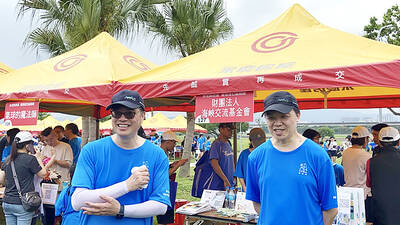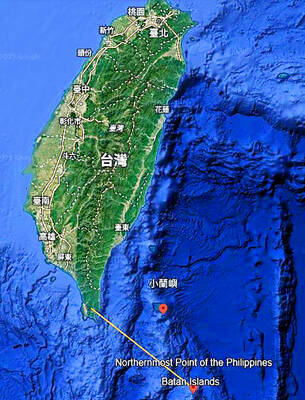With many people worried about getting sick -- whether from the common cold or exotic new strains of antibiotic-resistant bacteria -- Paul and Jeffrey Metzger had reason to hope that the germ-fighting key fob they invented would be a hit.
Their device, known as the Handler, began selling last year. It features a pop-out hook so germophobes can avoid touching surfaces where undesirable microbes may lurk. As added protection, the Handler's surfaces are impregnated with tiny particles of silver to kill germs that land on the device itself.
But the particles have run Maker Enterprises, the Metzger brothers' partnership, into trouble. The Metzgers realized that the Environmental Protection Agency (EPA) might decide that a law that regulates pesticides would apply to antimicrobial products like theirs.

PHOTO: NY TIMES NEWS SERVICE
The agency ruled last fall that the law covered Samsung's Silvercare washing machine. Samsung was told it would have to register the machine as a pesticide, a costly, time-consuming process, because it claims the silver ions generated by the washer kill bacteria.
The Metzgers halted production of their key fob while they sought legal guidance on how to avoid a similar fate.
Their quandary highlights a challenge facing entrepreneurs who have ventured into nanotechnology, a field that relies on materials so small their dimensions are measured in billionths of a meter.
The Handler is one of many products marketing the antimicrobial potency of tiny quantities of silver.
The EPA has so far rejected calls from environmental groups to automatically classify nanoscale forms of materials as new chemicals under the broad toxic chemical control regulations. Nor does the agency consider size when determining what needs to be registered under its pesticide regulations. The effort to squeeze nanomaterials into existing regulations has left firms worried about how to market products without falling foul of regulators.
The law at issue -- the Federal Insecticide, Fungicide and Rodenticide Act, better known as FIFRA -- was conceived in 1947 to protect humans from agri-chemicals. In the case of the Handler, the question is how the law applies to barely measurable amounts of silver that are intended to be strictly confined instead of spread into the environment.
Silver's sterilizing powers are well-known, but no one can be certain that long experience with the metal is a complete guide to its hazards in its newly engineered forms. Nanoscale particles are often very potent. They may also have other unexpected properties that will become apparent only if many people are exposed to significant quantities over long periods of time.
One of the biggest concerns with such particles is that they may penetrate the brain and other organs that larger particles cannot reach.
Moreover, some critics worry that the technology may contribute to the evolution of microbes resistant to silver poisoning. And some health experts say that constantly reducing exposure to troublesome microbes may eventually weaken the human immune system.
Environmental groups point out that pesticide regulators may simply ignore an antimicrobial product if its manufacturer and distributors avoid making health claims. As the EPA interprets the regulation, a product is not "designed" to be a health-protecting antimicrobial if it is not advertised as such.
The agency said its handling of earlier antimicrobial products, especially the synthetic disinfectant triclosan, provided a model for nanosilver. Companies that had rushed to market with products impregnated with triclosan ended up paying fines and changing their labels. Many triclosan products have since been registered under the pesticide law.

SECURITY: As China is ‘reshaping’ Hong Kong’s population, Taiwan must raise the eligibility threshold for applications from Hong Kongers, Chiu Chui-cheng said When Hong Kong and Macau citizens apply for residency in Taiwan, it would be under a new category that includes a “national security observation period,” Mainland Affairs Council (MAC) Minister Chiu Chui-cheng (邱垂正) said yesterday. President William Lai (賴清德) on March 13 announced 17 strategies to counter China’s aggression toward Taiwan, including incorporating national security considerations into the review process for residency applications from Hong Kong and Macau citizens. The situation in Hong Kong is constantly changing, Chiu said to media yesterday on the sidelines of the Taipei Technology Run hosted by the Taipei Neihu Technology Park Development Association. With

CARROT AND STICK: While unrelenting in its military threats, China attracted nearly 40,000 Taiwanese to over 400 business events last year Nearly 40,000 Taiwanese last year joined industry events in China, such as conferences and trade fairs, supported by the Chinese government, a study showed yesterday, as Beijing ramps up a charm offensive toward Taipei alongside military pressure. China has long taken a carrot-and-stick approach to Taiwan, threatening it with the prospect of military action while reaching out to those it believes are amenable to Beijing’s point of view. Taiwanese security officials are wary of what they see as Beijing’s influence campaigns to sway public opinion after Taipei and Beijing gradually resumed travel links halted by the COVID-19 pandemic, but the scale of

A US Marine Corps regiment equipped with Naval Strike Missiles (NSM) is set to participate in the upcoming Balikatan 25 exercise in the Luzon Strait, marking the system’s first-ever deployment in the Philippines. US and Philippine officials have separately confirmed that the Navy Marine Expeditionary Ship Interdiction System (NMESIS) — the mobile launch platform for the Naval Strike Missile — would take part in the joint exercise. The missiles are being deployed to “a strategic first island chain chokepoint” in the waters between Taiwan proper and the Philippines, US-based Naval News reported. “The Luzon Strait and Bashi Channel represent a critical access

Pope Francis is be laid to rest on Saturday after lying in state for three days in St Peter’s Basilica, where the faithful are expected to flock to pay their respects to history’s first Latin American pontiff. The cardinals met yesterday in the Vatican’s synod hall to chart the next steps before a conclave begins to choose Francis’ successor, as condolences poured in from around the world. According to current norms, the conclave must begin between May 5 and 10. The cardinals set the funeral for Saturday at 10am in St Peter’s Square, to be celebrated by the dean of the College